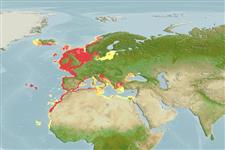>
Eupercaria/misc (Various families in series Eupercaria) >
Labridae (Wrasses)
Etymology: Labrus: Name from Latin 'labrum' for lip, rim or edge; referring to the big lips of the fishes of the genus (from Ovid and Pliny according to Petrus Artedi)..
More on author: Linnaeus.
Environment: milieu / climate zone / depth range / distribution range
Ecología
marino asociado a arrecife; no migratorio; rango de profundidad 2 - 200 m (Ref. 5292), usually 40 - 80 m (Ref. 4742). Subtropical; 68°N - 12°N, 32°W - 34°E
Eastern Atlantic: Norway south to Senegal, Azores and Madeira. Also in the Mediterranean.
Length at first maturity / Tamaño / Peso / Age
Maturity: Lm 16.0 range ? - ? cm
Max length : 40.0 cm SL macho / no sexado; (Ref. 3397); 30.0 cm TL (female); common length : 30.0 cm SL macho / no sexado; (Ref. 4742); edad máxima reportada: 20 años (Ref. 35388)
Adults are found in the algal zone of rocky shores (Ref. 35388). Usually solitary or in pairs with young. Females lay about 1,000 eggs in a nest of algae; the nest is guarded by the male (Ref. 35388). Feed mainly on crustaceans but also fishes and mollusks (Ref. 4742) and worms (Ref. 35388). Oviparous (Ref. 205).
Oviparous, distinct pairing during breeding (Ref. 205). Males build dish shaped nests and guard the eggs (Ref. 205). Sex reversal is completed in 7 months (Ref. 34185, 34259).
Quignard, J.-P. and A. Pras, 1986. Labridae. p. 919-942. In P.J.P. Whitehead, M.-L. Bauchot, J.-C. Hureau, J. Nielsen and E. Tortonese (eds.) Fishes of the north-eastern Atlantic and the Mediterranean. UNESCO, Paris. Vol. 2. (Ref. 4742)
IUCN Red List Status (Ref. 130435)
Threat to humans
Harmless
Human uses
Pesquerías: pesquerías de subsistencia; pesca deportiva: si; Acuario: Acuarios públicos
Herramientas
Special reports
Download XML
Fuentes de Internet
Estimates based on models
Preferred temperature (Ref.
123201): 7 - 17.1, mean 10 °C (based on 279 cells).
Phylogenetic diversity index (Ref.
82804): PD
50 = 0.5625 [Uniqueness, from 0.5 = low to 2.0 = high].
Bayesian length-weight: a=0.00851 (0.00509 - 0.01424), b=3.10 (2.96 - 3.24), in cm total length, based on LWR estimates for this species & (Sub)family-body (Ref.
93245).
Nivel trófico (Ref.
69278): 3.9 ±0.62 se; based on food items.
Generation time: 8.3 ( na - na) years. Estimated as median ln(3)/K based on 1
growth studies.
Resiliencia (Ref.
120179): Bajo, población duplicada en un tiempo mínimo de 4.5-14 años (K=0.13; tmax=17; tm=2; Fec=1,000).
Fishing Vulnerability (Ref.
59153): High vulnerability (58 of 100).
Nutrients (Ref.
124155): Calcium = 21.7 [10.4, 46.2] mg/100g; Iron = 0.475 [0.255, 0.932] mg/100g; Protein = 19.1 [16.3, 21.4] %; Omega3 = 0.238 [0.134, 0.411] g/100g; Selenium = 18.1 [8.8, 37.2] μg/100g; VitaminA = 81.7 [22.4, 355.0] μg/100g; Zinc = 0.868 [0.558, 1.412] mg/100g (wet weight);
